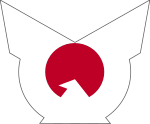
Back İmperator Hakimiyyətinə Kömək Assosiasiyası Azerbaijani Тайсей Йокусанкай Bulgarian Associació de Suport al Règim Imperial Catalan Asociace pro podporu trůnu Czech Taisei Yokusankai German Taisei Yokusankai Spanish انجمن حمایت از قانون امپراتوری Persian Association de soutien à l'autorité impériale French טאיסיי יוקוסאנקאי HE Asosiasi Asistensi untuk Pemerintahan Kekaisaran ID
You can help expand this article with text translated from the corresponding article in Japanese. (September 2019) Click [show] for important translation instructions.
|
This article is missing information about the merging of all political parties into the association before the 1942 Japanese general election, military influence and lengthier comparisons to the Nazi Party and National Fascist Party. (March 2021) |
Imperial Rule Assistance Association 大政翼贊會Taisei Yokusankai | |
|---|---|
 | |
| President |
|
| Deputy President |
|
| Founder | Fumimaro Konoe[1] |
| Founded | 12 October 1940 |
| Dissolved | 13 June 1945 |
| Merger of | |
| Headquarters | Chiyoda, Tokyo, Empire of Japan[2] |
| Youth wing | Great Japan Youth Party |
| Women's wing | Greater Japan Women's Association[3][4] |
| Paramilitary wing | Young Men's Corps[5][6] Volunteer Corps |
| Ideology | Statism |
| Religion | State Shintō |
| Political wing | Imperial Rule Assistance Political Association[10] |
| Colours | Red White |
| Anthem | Taisei Yokusan no Uta[11] |
| Imperial Rule Assistance Association | |||||
|---|---|---|---|---|---|
| Japanese name | |||||
| Kana | たいせいよくさんかい | ||||
| Kyūjitai | 大政翼贊會 | ||||
| Shinjitai | 大政翼賛会 | ||||
| |||||
| Part of a series on |
| Statism in Shōwa Japan |
|---|
 |
The Imperial Rule Assistance Association (Japanese: 大政翼贊會/大政翼賛会, Hepburn: Taisei Yokusankai), or Imperial Aid Association, was the Empire of Japan's ruling political organization during much of the Second Sino-Japanese War and World War II. It was created by Prime Minister Fumimaro Konoe on 12 October 1940, to promote the goals of his Shintaisei ("New Order") movement. It evolved into a "statist" ruling political party which aimed at removing sectionalism and factionalism from politics and economics in the Empire of Japan, creating a totalitarian one-party state in order to maximize the efficiency of Japan's total war effort against China and later the Allies.[12] When the organization was launched officially, Konoe was hailed as a "political savior" of a nation in chaos; however, internal divisions soon appeared.
- ^ Berger, Gordon M. (1974). Japan's Young Prince. Konoe Fumimaro's Early Political Career, 1916–1931. Monumenta Nipponica. 29 (4): 451–475. pp. 473–474. doi:10.2307/2383896. ISSN 0027-0741. JSTOR 2383896.
- ^ ^ 東京會舘編『東京會舘いまむかし』(東京會舘、1987年)、pp.159-162
- ^ 婦人団体を統合、婦道修練を目指す(『朝日新聞』昭和15年6月11日夕刊)『昭和ニュース辞典第7巻 昭和14年-昭和16年』p428 昭和ニュース事典編纂委員会 毎日コミュニケーションズ刊 1994年
- ^ ja:米田佐代子 [in Japanese]. "大日本婦人会 だいにほんふじんかい". Encyclopedia Nipponica. Shogakukan. Retrieved 8 January 2017.
- ^ Shillony, Ben-Ami (1981). Politics and Culture in Wartime Japan. Oxford University Press. pp. 23–33, 71–75. ISBN 0-19-820260-1.
- ^ Payne, Stanley G. (1996). A History of Fascism, 1914-1945. Routledge. p. 335. ISBN 1-85728-595-6.
- ^ Baker, David (June 2006). "The political economy of fascism: Myth or reality, or myth and reality?". New Political Economy. 11 (2): 227–250. doi:10.1080/13563460600655581. S2CID 155046186.
- ^ McClain, James L. (2002). Japan: A Modern History. New York: W. W. Norton & Company, Inc. pp. 454. ISBN 0393041565.
Conservatives such as Hiranuma Kiichiro, who served as prime minister for eight months in 1939, objected that the proposed totalitarian IRAA was nothing but a "new shogunate" that would usurp the power of the emperor's government, and Japanists declared that the national polity, the hallowed kokutai, already united the emperor with subjects who naturally fulfilled their sacred obligation to "assist imperial rule." On a more mundane plane, senior officials within the Home Ministry feared the loss of bureaucratic turf and complained that the proposed network of occupationally based units would interfere with local administration at a particularly crucial time in the nation's history.
- ^ Brandon, James R., ed. (2009). Kabuki's Forgotten War: 1931-1945. University of Hawaii Press. p. 113. ISBN 9780824832001.
.2 All existing political parties "voluntarily" dissolved themselves, replaced by a single authorized political body, the ultranationalist Imperial Rule Assistance Association.
- ^ Edward J. Drea, The 1942 Japanese general election: political mobilization in wartime Japan (Lawrence: Center for East Asian Studies University of Kansas, 1979), 145.
- ^ "大政翼賛の歌 / Taiseiyokusan'nouta / Anthem of Taisei Yokusankai - With Lyrics". Archived from the original on 28 April 2021.
- ^ Wolferen, The Enigma of Japanese Power: People and Politics in a Stateless Nation, page 351